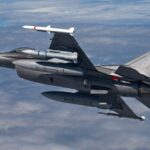
The U.S. Defense Department’s F-35 Lightning II joint program office plans to modify more than 200 early-production jets to bring them up to newer configurations, the program’s leader said Feb. 28.Aircraft from Low Rate Initial Production (LRIP) Lots 2 through 8 will receive a mix of hardware and software updates to reflect design improvements that were developed after those aircraft were built, Navy Vice Adm. Mat Winter told reporters. Winter said he expects those early aircraft to experience increased reliability after the…

 By
By 











